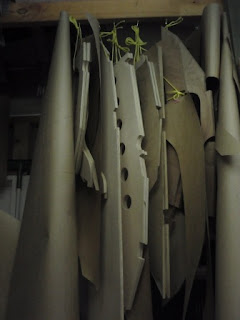Now, where is my lovely wife with my coffee and that brush and pan...she does such a good job when I need some tidying done in the shed.

Ah yes...the transom...
At the outset I wanted a modified transom area that would accommodate an insulated lazarette locker with a drain for ice and cold storage of liquid refreshments. I was quite concerned that because I was deviating from Johns plans and "flying solo" so to speak I was on shaky ground when it came to this part of the boat so I decided to build the entire transom locker arrangement with frame 6a as a sub assembly on the bench.
The result is very pleasing and in fact I think it made fitting the chine stringer and seat fronts a lot easier for two reasons:
1. I could fit the chine stringer to the ply bottom and trim it before installing the transom and
2. Standing the transom up at the correct angle off line gave me more confidence because there is no turning back when you are epoxying to the bottom plank.

I have since installed the assembly into the boat and put additional drains in. I have drained the ice box (starboard side) and centre lazarette locker into the cockpit and drained the cockpit into the motor well because I dont want holes in the transom. I'm not sure that this was in fact the best option but it is done so time will tell. Actually the transom assembly was pretty time consuming because of all the fiddly bits. I plan to use the centre locker for my grab bag with flares etc. There is sufficient space between the tiller and the top of the locker for the day storage of cell phone, vhf, sunnies etc. or if required a small auxilary fuel tank for the outboard. I have left a small lip to stop things falling off the top of the locker.









 I still need to do a final sand, dry fitting and paint. I can't do a real dry fit the centreboard to the case until later when I roll the boat or cut the obstructing cross members from the building frame - probably once the planks are in place. She seems to go in ok upside down from the top.
I still need to do a final sand, dry fitting and paint. I can't do a real dry fit the centreboard to the case until later when I roll the boat or cut the obstructing cross members from the building frame - probably once the planks are in place. She seems to go in ok upside down from the top.










